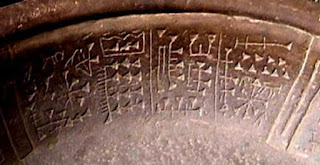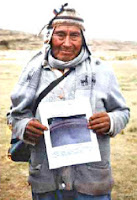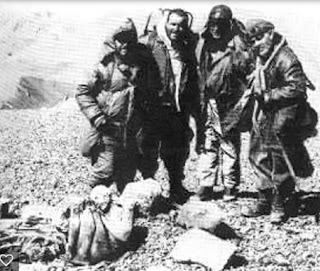To understand this fully, it is important to recognize that part of the problem of information dissemination lies with the uninitiated, the casual studier, the armchair history buff, who tend to accept the opinions of so-called professionals without checking their reasoning and how their “facts” are obtained, studied, and disseminated. Take for example, the original attitude about the Inca woven textiles called t’oqapu (tocapu). Evidently, during Inca times, the nobility wore certain fine dress and elaborate costumes of high quality and fabric. Along came the chroniclers who saw the special square patterns on finely woven fabrics and decided that these were the patterns referred to by the Inca nobility.
Left: Tocapu of Peru; Right: Hieroglyphs of
Guatamala. Both are similar in that they were originally considered nothing
more than designs. Today, one has been deciphered, the other is still being
worked on for a key
Thus, it was labeled
Tocapu or Tocapo: “toka” meaning
surgir (to emerge) or emanate, and “Apu”
meaning “sacred mountain.” Thus, the quality and fabric of embroidery work, but
not of the design, became the point of interest--a sacred work because it was for the nobility. Yet, because it was a “square”
design (a design using repetitive squares though the squares were of different
content), this became the meaning of the Tocapo design, i.e., used for the
nobility in expensive or finely made dress.Once established (accepted) any additional idea had to fit into that basic concept, or it was either rejected or a demand and proof of why it was more correct than the presently held belief. Thus, today we are saddled with an understanding that might be invalid based on the language work that has been done and the additional knowledge acquired, but it is still difficult to unseat an entrenched belief among the “professionals.”
Another instance of a discovery not fitting into the established time frame is the Fuente Magna scripts with Vai writing discovered in Pokotia, Bolivia, near Lake Titicaca, inscribed on a bowl.
If these were in standard Sumerian
characters, the bowl could be around 5000 years old; however, it was
discovered they were proto- Sumerian,
making them 3000 to 2000 year old characters, obviously engraved after that
time
Unfortunately, at the
time of being discovered, no one could read this particular Sumerian cuneiform
script because the "professionals" refused to compare Proto-Elamite and Proto-Sumerian writing
with other writing systems used in 3000-2000 BC. So the find was discarded as
of little to no value and the science world lost interest in it. Fortunately,
later Dr. Clyde A. Winters discovered it was Proto-Sumerian; however, instead
of looking into why this Mesopotamia script was engraved on a bowl in Andean
Peru dated to around the last millennia B.C. (Because they are Proto-Sumerian,
it is anyone’s guess how old the artifact really is), it was quickly dismissed
as being something believed to have been brought to the New World by Sumerians
in a ship and no connection was made to the indigenous people of the continent.
However, at the clearest estimate, the bowl represents people who settled in
the Bolivia area around Lake Titicaca sometimes after 2500 B.C., if not later—and they had a writing system that they used.
The problem lies in the lack of documentation as to its finding. Had an archaeologist dug this out of the ground, it would have revolutionized Andean archaeology and our understanding of ancient Peruvian languages. Unfortunatley, the bowl is claimed to have been found by a worker known only as Maximilian, who called it el plato del chancho (“the pig bowl”) who claimed forty years after the event, at the age of 92, that he had earlier found the bowl while working on the Manjon family property referred to as the Chúa Hacienda. An event that archaeologists cannot verify. Thus, they feel there is no credibility, though the bowl exists and has been judged by some experts to be authentic, though not by all.
Unfortunately, we cannot expect the Old Guard to change their opinions on matters they have held sacrosanct for decades—after all, since the Spanish arrived, it was noted and long held belief that the Inca did not have a written language. Yet there is a movement today along the fringes of that belief system that may change the entire approach to viewing such long-held beliefs as whether or not the early Peruvians had a written script language. This is due to the fact that ideas continue to generate among researchhers regarding the Tocapu as an actual language as de la Jara first stated in his studies regarding its logographic writing.
Known researchers are now taking up the work to interpret this graph and complex set of markings. Those from the likes of William Burns Glynn, Thomas S. Cummings, Marius Ziólkowski, Margarita Gentile, Mary Frame, Tom Zuidema and Gail Silverman recently have focused their study on these different approaches. Some with the view that writing was a phonetic or semasiographic form; and others defending the concept they were symbols or emblems that denoted hieratic prestige for the elite and even ritual expressions, perhaps somewhat like European iconographic heraldry on coasts of arms, etc.
It was the Basque Mercedarian friar and chronicler Martin de Murúa (1613), believing as did almost all the early Spanish in Peru, that all things unknown had to be of the devil and considered the markings as idols, writing that Guaina Capac "... among his many idols had an X and a sign as writing square and crossed as cross ..." (Historia general del Piru written 1580-1616, which is considered the earliest illustrated history of Peru). The description of this idol and comparison referred to the so-called scribe marks were the drawings with which the scribes of the era accompanied their headings. Murúa did not say that these squares in the textiles were part of a system of writing, but assumed that the drawings on clothes, of which he saw were drawings of idols.
According to Luis Eduardo Valcárcel Vizcarra, as early as 1958, saw in these “language” squares that “some of them were in tune with etnohistoria data, including interdisciplinary area studies Andean archaeology late colonial history, language folklore” (Historia del Peru, Historia del Peru Antiguo, Tomo II, Baca, Lima, 1978, Historia del Peru). While the scientific community lost interest in such ideas, there were still those who saw in the tocapu a lack of design, but a work the was a framework graphically limited to a drawing that said something.
In 1979 the American engineer William Burns Glynn, who was the President of the Academia Mayor de la Lengua Quechua in Cuzco, and during World War II, served as communications expert at the Royal Corps of Signal and participated in the invasion of Europe, arrived in Peru in 1956 where he studied both textile design and quipu. He wrote the Secret Writing of the Incas, which outlined a prehispanic alphanumeric writing system, which was accepted by the scientific community.
Juan
Schobinger (third from left) along with Groch,Kirby, and Razquina atop Cerro
Aconcagua along with mummy bundle of a frozen 7-year-old boy, part of an Incan
capacocha sacrifice 500 years ago
According to Margaret E. Gentile, Tocapu: Unit of Meaning in the Andean Graphic Language, building on
Juan Schobinger 1984 and J. Roberto Barcena 1988, wrote: “The hint that it was
possible to approach the understanding of geometric drawings and Andean tocapu in particular, appeared after the
publication of the components of the capacocha of Aconcagua,” which was an
excavated burial high on an Andean summit of 22,834-foot Mount Aconcagua, the
highest peak of the Andes, by Schobinger in 1985.(See the next post, “Quellqa: Ancient Written Language of Peru – Part IV,” for more information on how the sciences are possibly changing and looking at new insights into an early Peruvian writing system and also why the Inca had no writing system when the Spanish arrived)









No comments:
Post a Comment